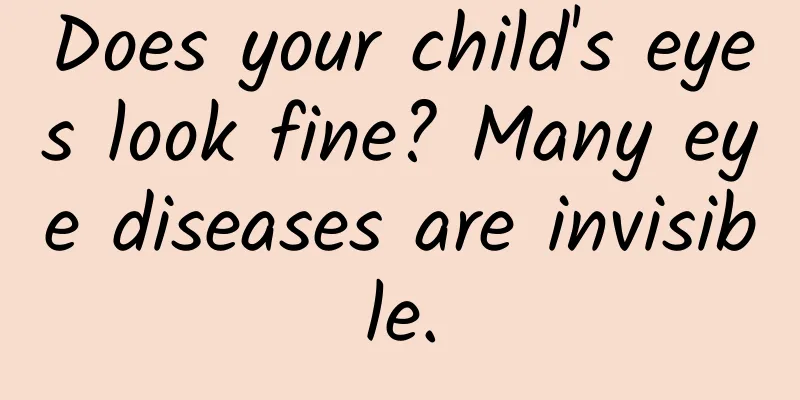Does your child's eyes look fine? Many eye diseases are invisible.

|
"My child's eyes are fine, why should I take him/her to the hospital?" Many parents think this way. After reading this article, your understanding may change, and the benefits may exceed your imagination. Although the eyeball is small, not even as big as a ping-pong ball, do you know how many eye-related diseases there are? According to the International Classification of Diseases (ICD-10), there are 823 eye-related diseases, most of which children will also suffer from. Many eye diseases may not have any obvious symptoms in the early stages, so they are ignored by parents, and they are not diagnosed and treated early, which delays the treatment of children. Dr. Jingcai has selected eye diseases that children of all ages need parents to pay attention to, and will introduce them to you: What “invisible” eye diseases may exist in children aged 0 to 3 years old? Children of this age have limited cognitive and expressive abilities, and many eye problems are not easily discovered by their parents. - Retinoblastoma . The most common malignant eye tumor in children, 90% of which occurs before the age of 3. The incidence rate is not high, about 1:20,000 (one in 20,000), but the consequences are serious and can even lead to the death of the child. This disease usually occurs in one eye. If parents are careful, they can observe that the pupil of one side of the child will reflect a yellow-white reflection under the light, which is very different from the other eye. At this time, they should seek medical attention immediately. A more proactive approach is to perform fundus examinations after the child is born and every year thereafter to detect it as early as possible. - Congenital cataracts . Cataracts are not exclusive to the elderly. Some children are born with them, and some are even very serious. The incidence rate in China is about 0.05%. This disease is painless and itchy. Children are young, so it is difficult for parents to detect it without going to the hospital for examination. Severe cataracts can cause blindness, and for infants and young children, it can also affect the normal development of visual function, which is very serious. -Neonatal dacryocystitis . The incidence rate is about 6% in newborns. It usually manifests as tearing, increased eye secretions, redness and swelling below the inner corner of the eye (where the lacrimal sac is located), etc. If it is not serious, the above symptoms may not be obvious and may be easily ignored by careless parents, thus becoming more serious and even complicated by serious corneal infection. - Refractive issues . Children of this age are still in the development stage of their eyes and vision. Normally, they are in a state of "physiological hyperopia". However, some children will have astigmatism or even develop myopia early. In this case, if parents do not take their children for a check-up, the children will not tell you - the children think that the blurry world in their eyes is normal because they are used to it, and parents cannot see what the world looks like in their children's eyes. If astigmatism and myopia are not corrected, they will develop into amblyopia over time. - Amblyopia . There is no organic lesion in the eye, but even if the refractive error is corrected as much as possible with glasses, the child's vision still cannot reach normal vision for the corresponding age group. - Glaucoma . Yes, even such a young child can get glaucoma. It is usually a congenital developmental problem. The child's intraocular pressure is higher than that of normal children. However, children of this age may not be able to express it, but often cry. Parents do not have professional knowledge and often cannot see any abnormalities in the appearance of the eyes. Severe glaucoma can cause blindness. What should we pay attention to for children aged 3 to 6? - The aforementioned refraction-related and amblyopia problems still need to be taken seriously . It’s just that children of this age have stronger communication skills and may tell their parents if they can’t see clearly. But parents should still take the initiative to take their children for a checkup once a year. - Starting from the age of 3, parents should help their children establish a refractive development file, recording the child's vision, refractive power, axial length and other indicators checked every year or every six months, until the child is 14 or even 18 years old. This data is very valuable and allows parents to cooperate with doctors to jointly judge the child's refractive development. The refractive file function of Tejingcai is simple and easy to use, you can try it. -Dry eyes . The incidence of dry eyes in children is not low. If you find that your child frequently blinks or rubs his eyes, even if there is no abnormality in the eyes, you should take your child to see a doctor in time. Severe dry eyes can affect the health of the corneal epithelium and even cause keratitis. -In addition, this age group is also an important stage for cultivating children's eye habits . Try to maintain sufficient outdoor light activity time every day, reduce close-range eye use, and prevent myopia. What about over 6 years old? When I was in primary school, myopia was my biggest enemy: - If the child has not yet developed myopia, he or she should be examined once a year, paying attention to the child's hyperopia reserve, naked eye vision, axial length and other indicators; - If your child has already developed myopia, please listen to the advice of ophthalmologists and optometrists to see if it is necessary to take relevant measures to control myopia (including OK lenses, multifocal soft lenses, specially designed frame lenses, low-concentration atropine eye drops, etc.), rather than just taking your child to get glasses on your own initiative; In summary, children of all ages have noteworthy and "invisible" eye diseases, and parents must be on guard. However, it is impossible for parents to know everything about eye diseases. The simplest way is to take your child to an ophthalmology hospital or optometry clinic for a comprehensive eye health check every six months, or at least once a year. 90% of human perception of the external world depends on vision, so it is completely worth doing so. If your child has not been to the ophthalmology or optometry clinic for a year or more, please take action now. If you find this article helpful, you are welcome to forward it to other parents. Dr. Eye Color believes that it will definitely help them. For more ophthalmology related knowledge, you can follow Tejingcai About Dr. Jingcai: The creators of Dr. Jingcai's popular science content all have a professional background in ophthalmology, a master's degree or above, and are former ophthalmologists. For some popular science content with a higher degree of professionalism, we will also invite working ophthalmologists and optometry experts to review and check it, striving to be responsible for the accuracy of the content and avoid misleading readers. |
<<: Basic knowledge about myopia
>>: Interesting Medicine Talk | Salmon Calcitonin (with audio)
Recommend
Body structure diagram of female uterus
The uterus is an internal organ that causes menst...
What to eat to make your period end quickly
I believe that every time you have your period, y...
A cold wave is coming, so it is imperative to keep warm!
Next week, a new round of cold air is coming. Peo...
What to do if the weather is bad for pickling fish? Can you dry the pickled fish in the sun if the weather is bad?
We all know that pickled fish is a common way of ...
What medicine should women take for acute urethritis
For women's normal life, it is often seriousl...
What happens if you use essential oils during your period?
Essential oils are a product that everyone uses. ...
Peking Union Medical College doctor says | How much do you know about screening for carriers of single gene genetic diseases?
Every couple of childbearing age is looking forwa...
How long is the pregnancy?
Pregnant women will undergo various prenatal exam...
[Medical Q&A] Is PCOS dangerous? Is it a tumor or ovarian cancer?
Planner: Chinese Medical Association Reviewer: Lu...
How to regulate menopausal arrhythmia
Menopausal arrhythmia is a symptom and also a typ...
What is the sand used to stir-fry chestnuts called? Why do we need sand to stir-fry chestnuts?
As people's lives become more and more abunda...
What happens when you are one week pregnant?
After a woman becomes pregnant, her body will usu...
What to do if pregnant women have nephritis
The symptom of nephritis in pregnant women has a ...
Common knowledge and significance of female sex hormone measurement
The content of sex hormones varies at different s...









